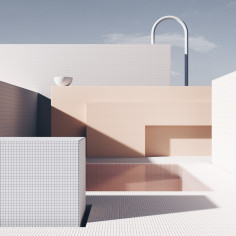ALEXIS CHRISTODOULOU

source: alexiscstudiocom
Alexis Christodoulou, a self-taught 3D artist living in Cape Town, South Africa has spent the last 6 years building a collection of works focusing on imaginary architecture. While working professionally as a copywriter for the last decade, Alexis taught himself 3D rendering as a hobby.
From a lifelong fascination of digital worlds and 3D graphics from playing video games a boy, Alexis became frustrated with the lack of modern aesthetics represented therein. The images he creates are a simple extension of this desire to see fantastic spaces come to life that echo a more modern and clean aesthetic.
.
.
.
.
.
.
.
source:ignantcom
Through imagination and impeccable design skills, Cape Town-based artist Alexis Christodoulou renders a world far more beautiful than ours through digital art.
Having worked as a copywriter for the past decade, Alexis became interested in rendering as a hobby — simultaneously satisfying his childhood fascination of artificial worlds, “Since I was young I’ve always been fascinated by the worlds created in video games,” he explains, “but became frustrated at their lack of modern aesthetics and tendency to always be rooted in fantasy, science fiction or some 20th century war.” As such, Alexis has established his own unique aesthetic — reimagining our world stripped of any unnecessary elements to heighten the focus on the form, structure and color choices which characterize each artwork.
The architectural sculptures are refined interpretations of real-world locations, designed as if reimagined in a dream. “The images I create are a simple extension of the desire to see fantastic spaces come to life that echoes a more modern and clean aesthetic,” he explains. Inspired by the architectural world around him, each render usually begins with a sketch of a space either inspired by a familiar building in Cape Town, or from renowned modern architecture. “It could be the muted tones of an Aldo Rossi drawing, concrete colliding with plaster from a David Chipperfield interior or a grid from a Superstudio drawing stretching on into infinity.” Alexis tells us. “Inspiration comes from many sources but I always try to create a space that interests me in form and material, but most importantly in the use of light.”
“My scenes are always void of any human beings…I’d prefer if you go explore by yourself.”
Architectural contours slither out of sight while looming passageways and infinite stairways lead to the unknown — prompting the viewer to question the narrative beyond the screen. Alexis characterizes each setting with a deliberate lack of human presence, creating a serene yet arguably eerie ambience. He explains this design decision, stating, “My scenes are always void of any human beings. I prefer the viewer to imagine how they would exist in the space, sometimes leaving a small clue as to a past presence but never leading you down any specific narrative. I’d prefer if you go explore by yourself.”
.
.
.
.
.
.
.
source:ad-magazinde
Unser Illustrator Alexis Christodoulou hat für die schönsten neuen Outdoor-Möbel vier postmoderne Plätze an der Sonne reserviert. Seit seiner Kindheit begeisterten die spielerischen Gestaltungsmöglichkeiten und der Look digitaler 3D-Welten Alexis Christodoulou. Inspiriert von seiner Leidenschaft wurde der gelernte Illustrator autodidaktisch zum meisterlichen 3D-Artist.
Für AD schuf der Christodoulou nun traumgleiche Architekturszenen, inspiriert von ikonischen und avantgardistischen Bauformen à la Bofill, Superstudio und Richard England. Seine künstlichen Welten erinnern mit ihren warmen Tönen an Sommernachmittage, -nächte und erfrischende Stunden am Pool. So inszenierte der Südafrikaner passend zur Saison die schönsten Outdoor-Möbel inmitten seiner ästhetisch feinfühligen Raumarrangements aus Farben, Formen und grafischen Pool-Landschaften.
.
.
.
.
.
.
.
source:good2bes
Alexis Christodoulou es un escritor y diseñador sudafricano, con sede en Ciudad del Cabo, especializado en técnicas de renders en 3D y 4D, las cuales, usa a su antojo para crear espacios arquitectónicos hiperrealistas, en sedantes y envolventes tonalidades pastel.
Sus localizaciones son tan reales como fantásticas, y ellas destacan varios aspectos: la ausencia física total del ser humano, la luz diurna brillante y perfectamente introducida en escena, y sobre todo en sus últimos trabajos, la presencia de agua. Estos aspectos, unidos a una composición muy renacentista y el efecto impoluto del render, consiguen que el espectador quede totalmente prendado a su visión del mundo.

